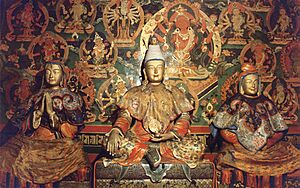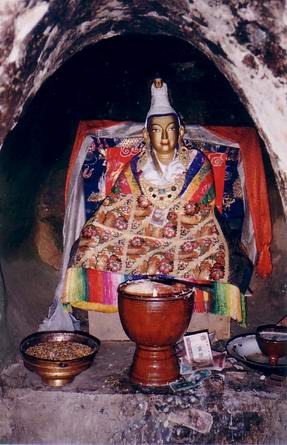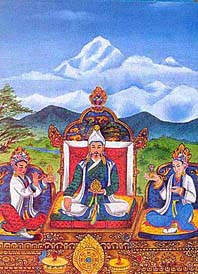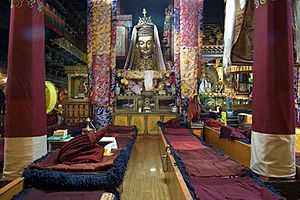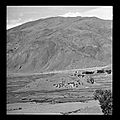Songtsen Gampo facts for kids
Quick facts for kids Songtsen Gampo |
|||||||||
|---|---|---|---|---|---|---|---|---|---|
| Emperor of Tibet | |||||||||
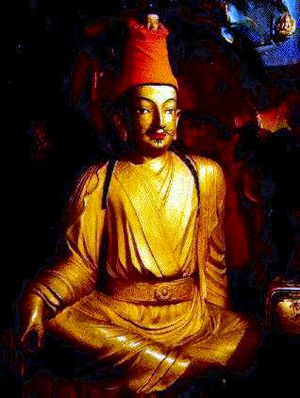 |
|||||||||
| Predecessor | Namri Songtsen | ||||||||
| Successor | Mangsong Mangtsen | ||||||||
| Born | Songtsen between 557 and 617 Maizhokunggar, Tibet |
||||||||
| Died | 649 Zal-mo-sgang, 'phun-yul, Tibet (in modern Lhünzhub County) |
||||||||
| Spouse | Pogong Mongza Tricham Bhrikuti (from Nepal, Licchavi kingdom) |
||||||||
| Issue | Gungsong Gungtsen | ||||||||
|
|||||||||
| Father | Namri Songtsen | ||||||||
| Mother | Driza Tökarma | ||||||||
| Religion | Tibetan Buddhism | ||||||||
Songtsen Gampo (born between 557 and 617, died 649) was a very important king in Tibet. He was the 33rd king and started the powerful Tibetan Empire.
He helped bring Buddhism to Tibet. He had two famous wives who were Buddhists: Bhrikuti from Nepal and Princess Wencheng from the Tang dynasty in China. Songtsen Gampo also helped create the Tibetan alphabet. This made Classical Tibetan the official language of Tibet at that time.
Historians are still trying to figure out his exact birth year. It might have been 569 or 605. This is because Tibet used a different calendar system.
Contents
Early Life of Songtsen Gampo
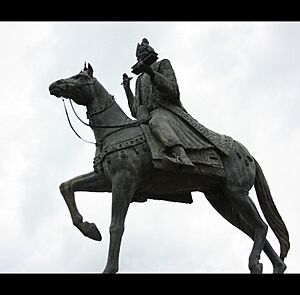
Songtsen Gampo was born at Gyama Palace in Meldro. This area is northeast of the modern city of Lhasa. His father was Namri Songtsen, who was the king of the Yarlung area.
Some Buddhist books say that Songtsen Gampo was a special person. They believe he was the human form of Avalokiteśvara. This is a very important figure in Buddhism. The Dalai Lamas are also thought to be human forms of Avalokiteśvara.
Songtsen Gampo's Family
Old documents from Dunhuang tell us about Songtsen Gampo's family. He had a sister named Sad-mar-kar. He also had a younger brother who died in a fire after 641. There might have been disagreements between his sister and brother.
Songtsen Gampo's mother was from the Tsépong family. She helped unite Tibet. Her name was Driza Tökarma.
According to Tibetan stories, Songtsen Gampo became king when he was 13 years old. This happened after his father was poisoned around the year 618. He was the 33rd king of the Yarlung Dynasty. Yarlung kings usually became king at 13. This was when they were considered old enough to ride a horse. If this is true, he might have been born in the year 605 CE. An old Chinese book, the Old Book of Tang, also says he was still young when he became king.
Wives and Children
Songtsen Gampo had six wives, but five are often mentioned:
- Pogong Mongza Tricham: She was the mother of his son, Gungsong Gungtsen.
- A noble woman from the Western Xia area.
- A noble woman from Zhangzhung.
- Bhrikuti: A princess from Nepal.
- Princess Wencheng: A princess from the Tang Dynasty in China.
In Tibetan tradition, his wives Princess Bhrikuti and Princess Wencheng were very important. They helped bring Buddhism to Tibet. The two main types of Tibetan Buddhism were influenced by India, Nepal, and China.
Songtsen Gampo's son, Gungsong Gungtsen, died before his father. Because of this, Songtsen Gampo's grandson, Mangsong Mangtsen, became the next king. Mangsong Mangtsen's mother might have been Princess Wencheng or another wife named Mangmoje Trikar.
Some stories say that when Gungsong Gungtsen turned 13, his father Songtsen Gampo retired. So Gungsong ruled for five years. They say Gungsong married 'A-zha Mang-mo-rje when he was thirteen. They had a son, Mangsong Mangtsen. Gungsong then died when he was 18. His father, Songtsen Gampo, then became king again.
What Songtsen Gampo Did for Tibet
Creating the Tibetan Alphabet
Songtsen Gampo wanted Tibet to have its own writing system. He sent a smart person named Thonmi Sambhota to India. Thonmi Sambhota created a new alphabet for the Tibetan language. This was a huge step for Tibet. It led to the first written books, literature, and even a set of laws.
Bringing New Culture and Technology
Songtsen Gampo brought many new ideas and technologies to Tibet. These came from different places.
In 648, an army from northern India attacked some Chinese people. Songtsen Gampo helped defeat this army. He worked with his Nepali and Chinese allies to protect the Chinese. In 649, the Chinese Emperor Gaozong gave Songtsen Gampo a special title. He also sent him 3,000 rolls of colorful silk. Emperor Gaozong also gave Tibet things like silkworm eggs, tools for making wine, and workers to make paper and ink.
Tools and knowledge about astrology came from China and the Western Xia area. The Buddhist religion and the art of writing came from India. Treasures came from Nepal and the Mongols. Laws were influenced by the Uyghurs from the north.
Introducing Buddhism to Tibet
Songtsen Gampo played a key role in bringing Buddhism to the Tibetan people. During his time as king, many Buddhist temples were built. People also started translating Buddhist texts from Sanskrit into Tibetan.
Building a Big Empire
Songtsen Gampo was a strong leader who expanded Tibet's power. He defeated the Sumpa people in northeastern Tibet around 627.
He might have conquered the Zhangzhung kingdom, which was in northern India and western Tibet. Some say this happened after he died. However, the Old Book of Tang says that in 634, the Yangtong (Zhangzhung) and other groups joined his empire.
He united the Yangtong people and defeated the 'Azha people. He then conquered two more tribes. After this, he threatened a Chinese city called Songzhou with a very large army.
He also conquered the Tangut people and other tribes. The Tangut people later formed their own kingdom called the Western Xia.
Marriage to Princess Bhrikuti of Nepal
The Old Book of Tang tells a story about Princess Bhrikuti. The king of Nepal died, and his uncle took over. The Tibetans helped the king's son, Naling Deva, get his throne back in 641. This made Nepal subject to Tibet.
Later, the Tibetans were attacked by an Indian king named Harsha. Naling Deva helped Tibet defeat Harsha's army. After this, Songtsen Gampo married Princess Bhrikuti, who was Naling Deva's daughter.
Marriage to Princess Wencheng of China
In 634 CE, Songtsen Gampo sent a group of people from Tibet to the Tang Dynasty in China. This was a "tribute mission" where Tibet gave gifts to the Tang emperor. He offered gold and silk and asked to marry a Tang princess. At first, the Tang emperor said no.
So, Songtsen Gampo attacked a part of the Tang empire called Songzhou in 637 and 638. But then he stopped and apologized. He asked for a wife again, and this time the Tang emperor agreed. Songtsen Gampo married Princess Wencheng, who was the niece of Emperor Taizong of Tang. This marriage helped create peace between the Tang and Tibetan empires.
Both Princess Wencheng and Princess Bhrikuti are seen as special figures in Buddhism. They are believed to be forms of Tara, who is the Goddess of Compassion.
Songtsen Gampo built a city and a palace just for Princess Wencheng.
The Chinese princess did not like that Tibetans painted their faces red. So, Songtsen Gampo told his people to stop this practice. He also changed his clothes from felt and skins to silk. He slowly started to copy Chinese ways. He sent the children of his chiefs and rich people to Chinese schools. He also invited Chinese scholars to help write official reports to the emperor.
Defending China's Envoy
A Chinese monk named Xuanzang visited King Harsha in India. Harsha then sent people to China. China sent an official named Wang Xuanze and others back to India. They traveled through Tibet.
Later, King Harsha was overthrown by a new ruler named Arjuna. In 648, Wang Xuanze made a second trip to India, but Arjuna treated him badly. So, the Tibetans and Nepalese helped defeat Arjuna.
Because of this help, in 649, the Chinese emperor Tang Gaozong gave Songtsen Gampo a special title.
Songtsen Gampo died in 649. In 650, the Tang emperor sent a message of sadness and sympathy. Songtsen Gampo's tomb is in the Chongyas Valley near Yalung. It is a large burial mound, 13 meters high and 130 meters long.
Images for kids
-
The Songtsen Library in Dehradun, India collects, preserves and makes accessible ancient Tibetan and Himalayan religious, cultural and historical documents
-
The burial mound of Songtsen Gampo surrounded by cultivated fields, (Chyongye Valley, 1949)
See also
 In Spanish: Songtsen Gampo para niños
In Spanish: Songtsen Gampo para niños


